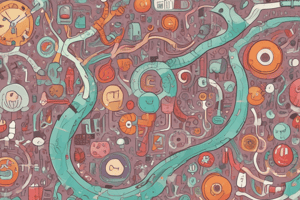Podcast
Questions and Answers
What is the first step in the catabolism of most amino acids?
What is the first step in the catabolism of most amino acids?
- Hydrolysis
- Oxidative deamination
- Dehydration
- Transamination (correct)
What is the primary source of amino acids in the amino acid pool?
What is the primary source of amino acids in the amino acid pool?
- Amino acids created during exercise
- Amino acids from dietary proteins (correct)
- Amino acids stored in the liver
- Amino acids from bacterial synthesis
Which enzyme is primarily involved in the process of transamination?
Which enzyme is primarily involved in the process of transamination?
- Aminotransferase (correct)
- Dehydrogenase
- Synthase
- Glutamate dehydrogenase
Which process primarily involves the removal of ammonia from amino acids?
Which process primarily involves the removal of ammonia from amino acids?
Which coenzyme is required by all aminotransferases?
Which coenzyme is required by all aminotransferases?
How does the body dispose of nitrogen from amino acids?
How does the body dispose of nitrogen from amino acids?
In which organs does oxidative deamination primarily occur?
In which organs does oxidative deamination primarily occur?
What are the three pathways utilized by the amino acid pool?
What are the three pathways utilized by the amino acid pool?
What role does ammonia play in amino acid catabolism?
What role does ammonia play in amino acid catabolism?
What role do digestive proteases play in amino acid metabolism?
What role do digestive proteases play in amino acid metabolism?
Which substance acts as an allosteric inhibitor of glutamate dehydrogenase?
Which substance acts as an allosteric inhibitor of glutamate dehydrogenase?
What happens to excess amino acids in the body?
What happens to excess amino acids in the body?
Which amino acids do not participate in transamination during their catabolism?
Which amino acids do not participate in transamination during their catabolism?
What is the primary function of the reactions involved in oxidative deamination?
What is the primary function of the reactions involved in oxidative deamination?
Which of the following is NOT a source of the amino acid pool?
Which of the following is NOT a source of the amino acid pool?
Which term describes the process of transferring an amino group from one amino acid to a keto acid?
Which term describes the process of transferring an amino group from one amino acid to a keto acid?
Study Notes
Disposal of Nitrogen in Amino Acids
- Amino acids are not stored in the body; they are sourced from diet, newly synthesized, or derived from protein degradation.
- Excess amino acids are rapidly degraded to prevent accumulation.
Amino Acid Pool
- The amino acid pool consists of free amino acids available throughout the body, sourced from:
- Degradation of body proteins
- Dietary protein intake
- Synthesis of nonessential amino acids from metabolic intermediates
- The amino acid pool serves three purposes:
- Synthesis of body proteins
- Precursor for nitrogen-containing small molecules
- Conversion to glucose, glycogen, fatty acids, or CO2
Digestion of Dietary Proteins
- Amino acid catabolism is integrated into nitrogen metabolism.
- Dietary proteins are primary sources of nitrogen.
- Nitrogen excretion occurs as urea, ammonia, and other products from amino acid metabolism.
Amino Acid Catabolism: Removal of Nitrogen
Transamination
- Transamination transfers the α-amino group of amino acids to α-ketoglutarate, forming α-ketoacids and glutamate.
- Catalyzed by aminotransferases, present in cytosol and mitochondria of various cells.
- All amino acids except lysine, threonine, and proline undergo transamination.
- Aminotransferases require pyridoxal phosphate, a vitamin B6 derivative.
Oxidative Deamination
- Primarily occurs in the liver and kidneys.
- Produces α-keto acids for energy metabolism and ammonia for urea synthesis.
- Glutamate dehydrogenase can use NAD+ or NADP+ as coenzymes; NAD+ is for oxidative deamination, while NADPH is for reductive amination.
- GTP inhibits glutamate dehydrogenase, while ADP activates it.
Transport of Ammonia to the Liver
- Ammonia generated from amino acid catabolism is transported to the liver for urea synthesis.
Summary
- Proper digestion of proteins occurs in the small intestine through specialized enzymes.
- The amino group is removed from free amino acids via transamination and oxidative deamination.
- The process is essential to manage nitrogen waste and maintain amino acid balance in the body.
Studying That Suits You
Use AI to generate personalized quizzes and flashcards to suit your learning preferences.
Related Documents
Description
This quiz focuses on how the body handles amino acids, specifically the processes of transamination and oxidative deamination. Dive into key concepts such as the amino acid pool and ammonia exchange among tissues. Gain a clearer understanding of amino acid metabolism and its implications for cellular function.




